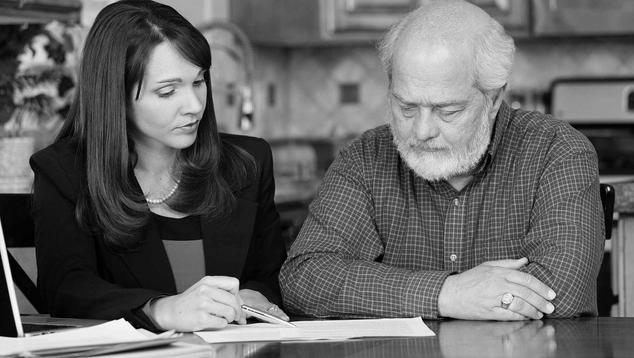Story Highlights
- 45% have a living will, up from 40% 15 years ago
- 74% favor ending terminal patients' lives by painless means
WASHINGTON, D.C. -- Forty-five percent of Americans say they have a living will, a slight increase from 40% in 2005, when Gallup last asked this question. The increase has come among those of higher socioeconomic status, with double-digit increases among college graduates and upper- and middle-income adults.
| May 2005 | May 2020 | Change | ||||||||||||||||||||||||||||||||||||||||||||||||||||||||||||||||||||||||||||||||||||||||||||||||||
|---|---|---|---|---|---|---|---|---|---|---|---|---|---|---|---|---|---|---|---|---|---|---|---|---|---|---|---|---|---|---|---|---|---|---|---|---|---|---|---|---|---|---|---|---|---|---|---|---|---|---|---|---|---|---|---|---|---|---|---|---|---|---|---|---|---|---|---|---|---|---|---|---|---|---|---|---|---|---|---|---|---|---|---|---|---|---|---|---|---|---|---|---|---|---|---|---|---|---|---|---|
| % | % | pct. pts. | ||||||||||||||||||||||||||||||||||||||||||||||||||||||||||||||||||||||||||||||||||||||||||||||||||
| U.S. adults | 40 | 45 | +5 | |||||||||||||||||||||||||||||||||||||||||||||||||||||||||||||||||||||||||||||||||||||||||||||||||
| Education | ||||||||||||||||||||||||||||||||||||||||||||||||||||||||||||||||||||||||||||||||||||||||||||||||||||
| Graduated from college | 44 | 55 | +11 | |||||||||||||||||||||||||||||||||||||||||||||||||||||||||||||||||||||||||||||||||||||||||||||||||
| Did not graduate from college | 38 | 39 | +1 | |||||||||||||||||||||||||||||||||||||||||||||||||||||||||||||||||||||||||||||||||||||||||||||||||
| Annual household income | ||||||||||||||||||||||||||||||||||||||||||||||||||||||||||||||||||||||||||||||||||||||||||||||||||||
| Lower-income | 36 | 28 | -8 | |||||||||||||||||||||||||||||||||||||||||||||||||||||||||||||||||||||||||||||||||||||||||||||||||
| Middle-income | 36 | 48 | +12 | |||||||||||||||||||||||||||||||||||||||||||||||||||||||||||||||||||||||||||||||||||||||||||||||||
| Upper-income | 47 | 59 | +12 | |||||||||||||||||||||||||||||||||||||||||||||||||||||||||||||||||||||||||||||||||||||||||||||||||
| Figures are the percentages who have a living will. Lower-, middle- and upper-income respondents assigned into rough thirds of the sample based on the income distribution. | ||||||||||||||||||||||||||||||||||||||||||||||||||||||||||||||||||||||||||||||||||||||||||||||||||||
| Gallup | ||||||||||||||||||||||||||||||||||||||||||||||||||||||||||||||||||||||||||||||||||||||||||||||||||||
These results are based on Gallup's annual Values and Beliefs poll conducted May 1-13 amid the coronavirus pandemic, which has resulted in the deaths of more than 100,000 Americans, the vast majority of whom are elderly.
Living wills are legal documents that allow people to state their wishes for end-of-life medical care in case they are unable to communicate those wishes.
Gallup first asked about living wills in 2005, in response to a highly publicized right-to-die legal case involving Terri Schiavo, a Florida woman whose husband sought to remove life support for her despite opposition from her parents, and ultimately, some state and federal elected officials.
Since that time, the gap between college graduates and nongraduates, and between lower-income and upper- and middle-income Americans, has increased. Majorities of college graduates and upper-income Americans now say they have a living will, compared with about four in 10 nongraduates and barely more than a quarter of lower-income Americans. While people are not required to hire a lawyer to prepare a living will, many do. The resulting fees make such a document more feasible for people of greater means.
As might be expected, older Americans are far more likely than younger Americans to have a living will. Seventy-two percent of adults aged 65 and older have a living will, as do a slim majority of those aged 50 to 64. A little more than a third of 30- to 49-year-olds have a living will, and only 15% of young adults do.
The increases since 2005 by age group are similar, apart from a slight decline among young adults.
| 2005 | 2020 | Change | |||||||||||||||||||||||||||||||||||||||||||||||||||||||||||||||||||||||||||||||||||||||||||||||||
|---|---|---|---|---|---|---|---|---|---|---|---|---|---|---|---|---|---|---|---|---|---|---|---|---|---|---|---|---|---|---|---|---|---|---|---|---|---|---|---|---|---|---|---|---|---|---|---|---|---|---|---|---|---|---|---|---|---|---|---|---|---|---|---|---|---|---|---|---|---|---|---|---|---|---|---|---|---|---|---|---|---|---|---|---|---|---|---|---|---|---|---|---|---|---|---|---|---|---|---|
| % | % | pct. pts. | |||||||||||||||||||||||||||||||||||||||||||||||||||||||||||||||||||||||||||||||||||||||||||||||||
| 18 to 29 | 19 | 15 | -4 | ||||||||||||||||||||||||||||||||||||||||||||||||||||||||||||||||||||||||||||||||||||||||||||||||
| 30 to 49 | 32 | 36 | +4 | ||||||||||||||||||||||||||||||||||||||||||||||||||||||||||||||||||||||||||||||||||||||||||||||||
| 50 to 64 | 46 | 52 | +6 | ||||||||||||||||||||||||||||||||||||||||||||||||||||||||||||||||||||||||||||||||||||||||||||||||
| 65+ | 67 | 72 | +5 | ||||||||||||||||||||||||||||||||||||||||||||||||||||||||||||||||||||||||||||||||||||||||||||||||
| Gallup | |||||||||||||||||||||||||||||||||||||||||||||||||||||||||||||||||||||||||||||||||||||||||||||||||||
One in Four Have Had to Decide on Life Support for a Family Member
Asked about their own experience with end-of-life issues, 25% of U.S. adults say they have been in a situation in which they had to make a decision about whether to remove life support for a family member. In 2005, 22% said they had been in such a situation.
As might be expected, older Americans are among the groups most likely to say they have had to decide about ending life support, with 35% saying so.
Fifty-eight percent of Americans who have had to decide about removing life support for a family member have a living will, compared with 40% who have not had to make such a decision. In all income groups, those who decided on end-of-life care for a family member are significantly more likely to have a living will than those who have not had to decide.
Public Still Broadly Supports Euthanasia
The poll also included Gallup's annual update on Americans' views of euthanasia. Seventy-four percent of U.S. adults say doctors should be allowed to end the life of a patient with an incurable disease "by some painless means" if the patient and the patient's family requests it.
This puts current support for euthanasia at the higher end of the historical range, just below the all-time high of 75% recorded twice previously -- in 1996 and 2005.
When Gallup first asked about euthanasia in 1947, Americans were more likely to oppose it (54%) than favor it (37%). A 1950 poll found similar results -- but by 1973, the majority of U.S. adults (53%) were in favor. Since then, no fewer than 64% have supported the practice.
Americans are less supportive of doctor-assisted suicide for patients living in severe pain with an incurable disease -- 61% say doctors should be allowed to assist such patients in committing suicide if they request it, while 37% are opposed.
A majority have consistently favored doctor-assisted suicide since Gallup first asked about it in 1996, though the percentage has varied from a low of 51% in 2013 to a high of 68% in 2001 and 2015.

Line graph. Consistent majorities have supported euthanasia and doctor-assisted suicide since 1996. However, support for euthanasia has always been higher, including 74% to 61% currently.
Although 61% of Americans believe doctors should be allowed to help patients commit suicide, fewer, 51%, think the practice is "morally acceptable," according to the results of a separate question in the survey. Just 18% of U.S. adults say suicide more generally is morally acceptable.
All key subgroups are more likely to support euthanasia than doctor-assisted suicide. Regular churchgoers and ideologically conservative adults are among the subgroups least supportive of each. Less than half of those groups think doctors should be allowed to help patients commit suicide.
| Euthanasia | Doctor-assisted suicide | ||||||||||||||||||||||||||||||||||||||||||||||||||||||||||||||||||||||||||||||||||||||||||||||||||
|---|---|---|---|---|---|---|---|---|---|---|---|---|---|---|---|---|---|---|---|---|---|---|---|---|---|---|---|---|---|---|---|---|---|---|---|---|---|---|---|---|---|---|---|---|---|---|---|---|---|---|---|---|---|---|---|---|---|---|---|---|---|---|---|---|---|---|---|---|---|---|---|---|---|---|---|---|---|---|---|---|---|---|---|---|---|---|---|---|---|---|---|---|---|---|---|---|---|---|---|
| % Favor | % Favor | ||||||||||||||||||||||||||||||||||||||||||||||||||||||||||||||||||||||||||||||||||||||||||||||||||
| U.S. adults | 74 | 61 | |||||||||||||||||||||||||||||||||||||||||||||||||||||||||||||||||||||||||||||||||||||||||||||||||
| Men | 75 | 60 | |||||||||||||||||||||||||||||||||||||||||||||||||||||||||||||||||||||||||||||||||||||||||||||||||
| Women | 73 | 63 | |||||||||||||||||||||||||||||||||||||||||||||||||||||||||||||||||||||||||||||||||||||||||||||||||
| Whites | 77 | 63 | |||||||||||||||||||||||||||||||||||||||||||||||||||||||||||||||||||||||||||||||||||||||||||||||||
| Nonwhites | 65 | 60 | |||||||||||||||||||||||||||||||||||||||||||||||||||||||||||||||||||||||||||||||||||||||||||||||||
| 18 to 54 | 78 | 67 | |||||||||||||||||||||||||||||||||||||||||||||||||||||||||||||||||||||||||||||||||||||||||||||||||
| 55+ | 68 | 52 | |||||||||||||||||||||||||||||||||||||||||||||||||||||||||||||||||||||||||||||||||||||||||||||||||
| Graduated from college | 79 | 69 | |||||||||||||||||||||||||||||||||||||||||||||||||||||||||||||||||||||||||||||||||||||||||||||||||
| Did not graduate from college | 71 | 57 | |||||||||||||||||||||||||||||||||||||||||||||||||||||||||||||||||||||||||||||||||||||||||||||||||
| Republicans/Republican leaners | 70 | 51 | |||||||||||||||||||||||||||||||||||||||||||||||||||||||||||||||||||||||||||||||||||||||||||||||||
| Democrats/Democratic leaners | 81 | 71 | |||||||||||||||||||||||||||||||||||||||||||||||||||||||||||||||||||||||||||||||||||||||||||||||||
| Conservatives | 57 | 43 | |||||||||||||||||||||||||||||||||||||||||||||||||||||||||||||||||||||||||||||||||||||||||||||||||
| Moderates | 80 | 68 | |||||||||||||||||||||||||||||||||||||||||||||||||||||||||||||||||||||||||||||||||||||||||||||||||
| Liberals | 87 | 73 | |||||||||||||||||||||||||||||||||||||||||||||||||||||||||||||||||||||||||||||||||||||||||||||||||
| Attend church weekly | 55 | 39 | |||||||||||||||||||||||||||||||||||||||||||||||||||||||||||||||||||||||||||||||||||||||||||||||||
| Attend church monthly | 76 | 62 | |||||||||||||||||||||||||||||||||||||||||||||||||||||||||||||||||||||||||||||||||||||||||||||||||
| Seldom/Never attend church | 82 | 72 | |||||||||||||||||||||||||||||||||||||||||||||||||||||||||||||||||||||||||||||||||||||||||||||||||
| Euthanasia wording: When a person has a disease that cannot be cured, do you think doctors should be allowed by law to end the patient's life by some painless means if the patient and his or her family request it? Doctor-assisted suicide wording: When a person has a disease that cannot be cured and is living in severe pain, do you think doctors should or should not be allowed by law to assist the patient to commit suicide if the patient requests it? | |||||||||||||||||||||||||||||||||||||||||||||||||||||||||||||||||||||||||||||||||||||||||||||||||||
| Gallup, May 1-13, 2020 | |||||||||||||||||||||||||||||||||||||||||||||||||||||||||||||||||||||||||||||||||||||||||||||||||||
Implications
Americans largely favor allowing doctors to end the lives of terminally ill patients at those patients' request, or to assist such patients in doing it themselves.
A living will ensures patients' end-of-life wishes are carried out if they are unable to speak for themselves, but a majority of Americans do not have such a document. Although slightly more have one now than did 15 years ago, most of the increase has been among Americans of higher socioeconomic status. The gap between those of higher and lower socioeconomic status has widened as a result, showing another example of inequities in the U.S. healthcare and legal systems.
The gap may also reflect greater awareness of living wills among individuals of higher socioeconomic status. Those who have had to decide on end-of-life care, regardless of their income level, are significantly more likely to have a living will.
View complete question responses and trends (PDF download).
Learn more about how the Gallup Poll Social Series works.




